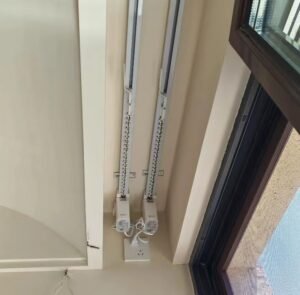Is the fear of receiving a shipment that doesn't meet specifications keeping you up at night? You've heard stories of quality issues, communication breakdowns, and unexpected costs when sourcing from overseas.
To avoid common mistakes when importing curtain tracks from China, you must rigorously verify suppliers, establish clear quality control standards, provide detailed technical specifications, and fully understand shipping Incoterms. Proactive management in these four areas is crucial for success.
I've been on both sides of this process. I started on the factory floor, seeing how products are made, and now I work with purchasing managers like Matt every day. I know that the difference between a successful import and a costly mistake often comes down to the details you establish before the container is even packed. It’s not about finding the cheapest price; it's about finding the right partner and setting up a system that prevents problems from happening in the first place. This guide is built on that practical, hands-on experience.
How Do You Verify the Quality of a Chinese Curtain Track Supplier?
Worried about partnering with a factory that can't deliver on its promises? Choosing an unvetted supplier based on price alone is a huge risk that can lead to project delays and poor quality.
Verify a Chinese supplier by requesting third-party factory audits, asking for industry-specific certifications (like ISO 9001), and ordering detailed product samples. A reputable manufacturer will be transparent and willingly provide documentation and evidence of their production capabilities and quality management systems.
In my early days, I learned that a slick website or a low price means nothing without proof of capability. A true manufacturing partner isn't just a seller; they are a professional operation with systems in place. When a potential client asks us for our quality control documentation or our business registration, I see it as a positive sign. It shows they are professionals. You should always ask for references from buyers in your own country. A supplier who is proud of their work will be happy to connect you with long-term partners.
Don't just look at their factory; look at their track record. This process separates the temporary trading companies from the dedicated, long-term manufacturers you want to build a business with.
What Are the Most Common Quality Control Issues with Curtain Tracks?
Have you ever received a batch of tracks where the finish was inconsistent or the gliders didn't run smoothly? These small defects can render an entire shipment unusable for a high-end project.
The most common quality issues are inconsistent powder coating or anodizing, low-grade aluminum that bends easily, and poorly molded plastic components (like end caps and gliders) that break or cause friction. A thorough quality control checklist is essential to catch these problems before shipment.
From my experience on the production line, I can tell you that consistency is everything. It's easy to make one perfect sample, but much harder to make 10,000 identical pieces. That's where a clear quality standard, or a "golden sample," becomes vital. Before we start mass production for a client, we agree on a master sample that becomes the benchmark for everything else. Your QC process should check for:
- Finish Thickness: Is the powder coating thick enough to prevent scratches?
- Color Consistency: Does the color match the approved sample under different lights?
- Smoothness Test: Do the gliders move effortlessly without noise or snagging?
- Component Fit: Do the end caps and brackets fit snugly without being loose?
A good supplier will not only welcome this scrutiny but will also have their own internal QC processes that mirror these checks.
How Can Clear Communication Prevent Customization Errors?
Afraid that the custom-curved tracks you ordered will arrive with the wrong dimensions? Miscommunication on technical details is one of the most expensive mistakes in the import business.
Prevent customization errors by using detailed technical drawings with precise measurements, tolerances, and specifications for all components. Always request a CAD drawing or production proof from the supplier for written approval before manufacturing begins. This creates a clear, shared record of the exact requirements.
I've seen simple language barriers lead to huge mistakes. Words like "smooth curve" or "standard 90-degree bend" can be interpreted differently. Numbers and technical drawings, however, are a universal language. When a client needs a custom bend for a bay window, we don't proceed until we have a signed-off drawing showing the exact radii, segment lengths, and bracket placement. This document becomes our manufacturing blueprint. My advice is to never assume anything. Be overly specific. Provide diagrams, label everything, and always get that final signed confirmation.
It feels like extra work upfront, but it saves thousands of dollars and weeks of delays on the back end. This step eliminates ambiguity and protects both you and the supplier.
Why Is Understanding Shipping Terms (Incoterms) So Important?
Have you ever been hit with unexpected shipping or customs fees that destroyed your project budget? Many importers don't fully understand where their responsibility begins and the supplier's ends.
Understanding Incoterms (like FOB, EXW, DDP) is critical because they define who is responsible for the goods at every stage of the shipping process, including cost, logistics, and risk. Choosing the wrong term can lead to huge, unforeseen expenses for freight, insurance, and customs clearance.
This is an area where I see many new importers make costly mistakes. For example, they accept a price based on EXW (Ex Works) because it looks the cheapest. But EXW means you are responsible for everything—from picking up the goods at our factory door in China to getting them to your warehouse. A more common term is FOB (Free On Board), where the supplier is responsible for getting the goods to the Chinese port and loaded onto the ship. You then take over for ocean freight, insurance, and import duties.
Here's a simple breakdown:
| Incoterm | Supplier's Responsibility | Your Responsibility |
|---|---|---|
| EXW (Ex Works) | Make goods available at their factory. | All transport, customs, and risk. |
| FOB (Free On Board) | Deliver goods to the port and load them. | Ocean freight, insurance, import. |
| DDP (Delivered Duty Paid1) | Deliver goods to your final destination, all costs paid2. | Unloading the goods. |
Not understanding these terms is like signing a contract without reading it. Always clarify the Incoterm in your purchase order to ensure there are no surprises.
Conclusion
In summary, successful importing from China relies on due diligence. By verifying suppliers, defining quality, communicating clearly, and understanding shipping terms, you can avoid common pitfalls and build reliable partnerships.








